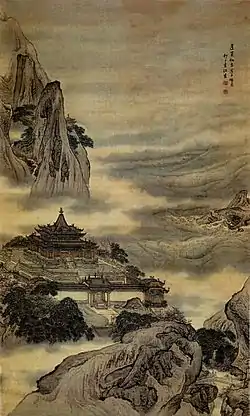Mount Penglai
Penglai (Chinese: 蓬萊仙島; lit. 'Penglai Immortal[1] Island') is a legendary land of Chinese mythology. It is known in Japanese mythology as Hōrai.[2]
| Mount Penglai | |
|---|---|
 "The Immortal Island of Penglai", by Chinese artist Yuan Jiang (1708), held by Palace Museum | |
| Genre | Chinese mythology |
| Information | |
| Type | Legendary island of immortals, Otherworld |
| Notable characters | The Eight Immortals |
| Mount Penglai | |||||||||||||||||
|---|---|---|---|---|---|---|---|---|---|---|---|---|---|---|---|---|---|
.svg.png.webp) "Penglai" in Traditional (top) and Simplified (bottom) Chinese characters | |||||||||||||||||
| Chinese name | |||||||||||||||||
| Traditional Chinese | 蓬萊仙島 | ||||||||||||||||
| Simplified Chinese | 蓬莱仙岛 | ||||||||||||||||
| |||||||||||||||||
| Japanese name | |||||||||||||||||
| Kanji | 蓬莱 | ||||||||||||||||
| |||||||||||||||||
| Part of a series on |
| Taoism |
|---|
 |
Location
According to the Classic of Mountains and Seas, the mountain is said to be on an island in the eastern end of Bohai Sea, along with four other islands where the immortals lived, called Fāngzhàng (方丈), Yíngzhōu (瀛州), Dàiyú (岱輿), and Yuánjiāo (員嬌).
Various theories have been offered over the years as to the "real" location of these places, including Japan, Nam-Hae (南海), Geo-Je (巨濟), Jejudo (濟州島) south of the Korean Peninsula, and Taiwan. Penglai, Shandong exists, but its claimed connection is as the site of departures for those leaving for the island rather than the island itself.
In Chinese mythology
In Chinese mythology, the mountain is often said to be the base for the Eight Immortals, or at least where they travel to have a ceremonial meal, as well as the illusionist Anqi Sheng. Supposedly, everything on the mountain seems white, while its palaces are made from gold and platinum, and jewels grow on trees.
There is no agony and no winter; there are rice bowls and wine glasses that never become empty no matter how much people eat or drink from them; and there are enchanted fruits growing in Penglai that can heal any ailment, grant eternal youth, and even raise the departed.
Historically, Qin Shi Huang, in search of the elixir of life, made several efforts to find the landmass where the mountain is located, to no benefit. Legends tell that Xu Fu, one servant sent to find the island, found Japan instead, and named Mount Fuji as Penglai.
In Japanese mythology
The presentation of Mt. Hōrai in Lafcadio Hearn's Kwaidan: Stories and Studies of Strange Things, is somewhat different from the earlier idyllic Chinese myth. This version, which does not truly represent the Japanese views of Horai in the Meiji and preceding Tokugawa periods, rejects much of the fantastic and magical properties of Hōrai. In this version of the myth, Hōrai is not free from sorrow or death, and the winters are bitterly cold. Hearn's conception of Hōrai holds that there are no magical fruits that cure disease, grant eternal youth or raise the dead, and no rice bowls or wine glasses that never become empty.
Hearn's incarnation of the myth of Hōrai focuses more on the atmosphere of the place, which is said to be made up not of air but of "quintillions of quintillions" of souls. Breathing in these souls is said to grant one all of the perceptions and knowledge of these ancient souls. The Japanese version also holds that the people of Hōrai are small fairies, and they have no knowledge of great evil, and so their hearts never grow old.
In the Kwaidan, there is some indication that the Japanese hold such a place to be merely a fantasy. It is pointed out that "Hōrai is also called Shinkiro, which signifies Mirage—the Vision of the Intangible".
See also
- Avalon
- Dilmun, paradise-island in the Epic of Gilgamesh
- Luggnagg, the island of the immortal struldbrugs in Jonathan Swift's Gulliver's Travels
- Tír na nÓg
- Shangri-La
References
- The character 仙 literally refers to a Daoist holy person/immortal or a mythological being, but is often used to describe places which exhibit the qualities of these beings.
- McCullough, Helen. Classical Japanese Prose, p. 570. Stanford Univ. Press, 1990. ISBN 0-8047-1960-8.
- "Horai". Kwaidan: Stories and Studies of Strange Things (digital version @ sacred-texts.com). Retrieved February 22, 2006.